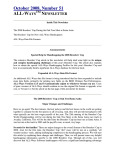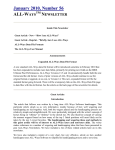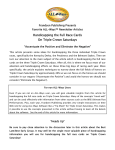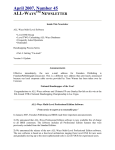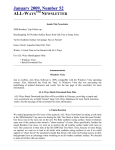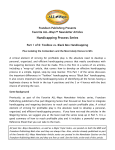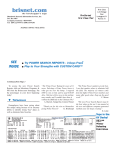Download July 2008, Number 50 ALL-WAYS
Transcript
July 2008, Number 50
ALL-WAYSTM NEWSLETTER
Inside This Newsletter
Playing the Exacta
Summer Specials
• ALL-Ways Custom Card
• AWS Batch Downloads
• Preparing for the Breeder’s Cup at Oak Tree
Announcements
Special July 2008 ALL-Ways Custom Card Promotion
Handicapping based on the specific pace scenario in a race is perhaps the very best way to find
the surprise horses that finish in-the-money at big prices. The ALL-Ways version of BRIS
Custom Card looks at all races being run at all tracks in North America and builds a custom
ALL-Ways data file made up just those races that match your selection criteria, including the
pace match-up scenario in the race. During the month of July 2008, you can download two
different ALL-Ways Custom Cards with up to 20 races each … absolutely free!
Oak Tree and Del Mar AWS Batch Downloads
Two economical batch files containing the ALL-Ways data files and corresponding results files
for every race run at Del Mar and for every race run at Oak Tree since the all weather surface
tracks were installed are available on the ALL-Ways Data File page on the BRIS Web site.
Please see the last page of this newsletter for more information about these special offers as
well as suggestions for getting prepared to handicap this year's Breeder's Cup races at Oak Tree.
Playing the Exacta
Common Sense vs. Calculator
Introduction
While we have touched on the subject in numerous newsletters, we have not devoted an entire
newsletter to the Exacta wager … until now!
The Exacta is one of the very best wagers in racing. We do not say this lightly. There are very
specific reasons why the Exacta is such a good wager. We explore these reasons below. We also
cover how to spot the best Exacta combination values to play in a race and we present a two part
process to handicap for the win and place horses and to effectively structure Exacta wagers to
maximize your return.
Why the Exacta is Such a Good Wager
There are only three types of wagers in racing where you know, with certainty, what a winning
wager will pay, before you place the bet. These three wager types are Win wagers, Daily Double
wagers and Exacta wagers. You can see what Exactas will pay by looking at the probable
payoffs which are continually updated right up to post time. It is not possible to overemphasize
how important this probable payoff information really is. It will let you spot the best win/place
horse Exacta combinations in terms of wagering value and it will help you structure your wagers
to maximize this value.
Exacta wagers with very good values present themselves frequently, mainly because the general
public is very ineffective at playing Exactas. They bet too many combinations, generally by
boxing too many horses. They over-bet combinations with the favorite and second favorite
horses. They bet on too many long shots. The combinations over bet by the public become poor
values. Conversely, combinations under bet by the public become the values we are looking for.
Playing for Value
You will continually see the word "value" when discussing how to play Exactas. Just what is
meant by "value"? There is a formula we learned many years ago that has proven to be a good
way to determine the Fair Payoff for any particular straight Exacta combination.
The Fair Exacta Payoff equals
$Bet x (Win Odds) x (Place Odds +1)
Here is how to read this formula. Fair Payoff for an Exacta equals the size of the bet, such as a
$2 Exacta, multiplied by the (win horse's odds-to-1) multiplied by the (place horse's odds-to-1
plus 1). The odds are each horse's going-off win odds.
For example, if the horse in the win position is going off at 3 to 1 and the horse in the place
position is going off at 4 to 1, the Fair Payoff for a $2 Exacta is:
$2 x (3) x (4 + 1) = $30
Another example: If the horse in the win position is going off at 4 to 1 and the horse in the place
position is going off at 5 to 1, the Fair Payoff for a $2 Exacta is:
$2 x (4) x (5 + 1) = $48
Using this concept, the Fair Payoff figure is the lowest payoff for the specific straight Exacta
combination that is deemed acceptable. The small table below shows the Fair Payoff figures for
different going-off-odds combinations. The odds of the horse in the Win slot are down the left
side and those for the horse in the Place slot along the top. We do not include horses going of at
less than 2-1 odds because they rarely yield value.
Fair Payoffs for $2 Exacta Wagers
Win
Horse
Odds-1
2
3
4
5
6
7
8
9
Place Horse Odds-1
2
12
18
24
30
36
42
48
54
3
16
24
32
40
48
56
64
72
4
5
6
7
20 24 28 32
30 36 42 48
40 48 56 64
50 60 70 80
60 72 84 96
70 84 98 112
80 96 112 128
90 108 126 144
8
36
54
72
90
108
126
144
162
9
40
60
80
100
120
140
160
180
Common Sense vs. Calculator
Being able to see the probable Exacta payoffs before you wager coupled with the concept of
"Fair Payoffs" is indeed powerful and important. Most articles you will read on playing the
Exacta will start with this Fair Payoff concept, just as we do. However, many of these other
articles go deeper into the mathematics, seeking more precision with variable "Edge" multipliers,
proportional wagering allocation and recovery of guaranteed losing combinations. These
concepts, rules and guidelines related to playing the Exacta, are certainly valid, but they scream
"C-A-L-C-U-L-A-T-O-R!" However, we have had solid success playing the Exacta
following these general concepts, but doing so more intuitively and using common sense in
lieu of a calculator. And, that is where we are now going to head.
Some Exacta Payoff Statistics
We used the Track Payoff Analysis built into ALL-Ways software to analyze the actual Exacta
payoffs at fourteen different tracks in North America. Our ALL-Ways Race Databases for these
tracks totaled approximately 26,000 races. The chart below shows the average Exacta payoffs for
All Weather Surface races, real dirt races and turf races based on the win odds of the actual
winning horse.
Average $2 Exacta Payoffs
Winning Horse Going-off-odds
Synthetic
Real Dirt
Turf
1-1
and
less
2-1
to
3-1
3-1
to
4-1
4-1
to
5-1
21
21
25
50
45
59
70
66
75
85
79
98
This chart shows us several helpful things. Turf races generally produce better payoffs than races
on real dirt or synthetic surfaces. This is due primarily to the typical pace scenarios in turf races
and, perhaps most important, to the typically larger field sizes in turf races. The somewhat higher
payoffs on synthetic surfaces compared to real dirt, is due primarily, we believe, to the added
complexity of handicapping synthetic surface races.
Top Level Value Plays
When we refer to "value plays", we are looking for straight Exacta combinations with probable
payoffs somewhat above the Fair Payoff figure. These value plays will be straight Exacta
combinations that are under bet by the public. Straight Exacta combinations that are over bet by
the public should be avoided. The public tends to over bet the first and second favorites in the
race. And, somewhat surprisingly, the public also tends to over bet long shots at 10-1 and higher.
This leads us to what we call "the Exacta Sweet Spot" which is to focus on horses going off in
the range of 3-1 up to 9-1. And, even if the favorite is in this range, we will generally not play
the favorite in the win position.
A Two Part Process
Successfully playing Exacta wagers requires a two part process. The first part is to handicap the
race for the potential win and place horses. The second part is to look for straight Exacta
combinations that offer sufficient value and to determine the structure of the wager. "Structure"
covers which specific combination(s) to play and how much to bet on each combination.
The Handicapping Part
We are not going to cover general handicapping principles here. We refer you to the list of
Related ALL-Ways Newsletters on the last page of this newsletter. What we are going to do now
is to focus on handicapping concepts that are particularly helpful for playing Exactas.
Caveat
We start with the caveat "Never say never." There are some solid guidelines for playing Exactas
that will serve you well 95% of the time, including such things as "Do not bet favorites in the
win position." and "Do not waste money on very high odds horses." As part of handicapping to
play an Exacta, we suggest always asking if there is a good reasons to break a general rule.
Exacta Handicapping Objectives
First, as we have said many times: "The fundamental goals of handicapping are to identify, in
advance, the two out of three races that are not won by the crowd favorite and to identify
the two non-favorite horses most likely to beat the favorite." For the Exacta, this gets further
refined to finding the place horse as well. And, we recommend your Exacta handicapping
process also look for a possible non-favorite Key-Horse that can be singled in both the win and
place positions.
Exacta Handicapping Guidelines
Here are some guidelines that have served us well when handicapping for the Exacta.
• Approach the handicapping task in a way that identifies one or more specific straight Exacta
win/place combinations. This will help avoid the tendency to box different horses and it will help
you assess the value of the probable payoffs.
• Some races are simply too contentious to play. Save money by passing such races in favor of
playing other races that you have figured out. If you have $200 to wager on Exactas on a ten race
card, it is generally best to not bet $20 on each of ten races, but to bet $40 on five races.
• If you play both Exactas and Trifectas, keep in mind that it is often better to play one large
Exacta then smaller Exactas and Trifectas in the same race. This is particularly the case if you
believe the favorite will not win, but may finish in the place or show position
• Do not box a bunch of horses to cover up insufficient and/or ineffective handicapping. Be
intellectually honest about this. If you can't figure out good straight Exacta combinations that
you have confidence in, pass the race.
Characteristics of Place Horses
Here are a number of characteristics that are helpful for identifying place horses.
Opposing Pace: This one is very strong and it happens frequently. The place horse often has a
running style that is the exact opposite of the winning horse. Consider this: As you watch the
horses coming down the stretch run approaching the finish line in a race, you are generally
rooting either for an early running horse to hold on or you are rooting for a closer to catch and
pass the front runner.
Not an Early ("E") Running Horse: Horses with an "E" running style, by definition, must get
and hold the lead. It is axiomatic in horse racing that when an "E" horse is passed by another
horse, far more often than not, the "E" horse gives up and is no longer a factor in the race. If you
think an "E" horse is going to get passed early to mid stretch, you can generally leave the horse
out of the Exacta.
Anti-Bias Horses: This is the case when a horse has a running style that is clearly going against
the track's pace bias. For example, horses with Presser ("P") or Sustainer ("S") running styles are
often the better candidates for the place position when running on the heavily early biased dirt
track at Belmont Park.
Unbalanced Horses: We consider a horse to be "unbalanced" if it has good speed, but lower
class or if it has high class, but lower speed. These horses are generally not good candidates to
win the race because they come up short and finish in the place spot.
"Seconditis": Some horse's figures look very good on paper, good enough to win the race, but
the horses come up short because they simply have a habit of finishing second. These horses tend
to "jump out at you" on past performance reports.
Pace Handicapping for Exactas
Using the concepts of pace is a particularly effective way to handicap for playing Exactas. We
already mentioned the Opposing Pace concept above. There are other pace considerations too.
Best Early-Best Late: ALL-Ways Newsletter #8 introduced a pace handicapping method we
called "Opposing Pace - Gap Strategy". This has proven to be an extremely effective way to
approach pace handicapping, particularly for playing Exactas. This method has you separate the
early running horses ("E" and "EP" horses) and the late running horses ("P" and "S" horses) in to
two separate groups and then use the concept of Gap handicapping to identify the best early
horse(s) and the best late horse(s) in each group. Gap handicapping includes looking at speed,
class, compound pace and comprehensive ratings. The best early horse(s) and the best late
horse(s) are the best candidates to include in your Exacta combinations. Note: The ALL-Ways
Top 10/Ranking Handicapping Report is a great tool for spotting the Gaps in as many as sixteen
different handicapping factors of your choosing.
Good Conditions for Closers: More often than not, the horses that finish in the win and place
positions at decent, mid- range odds, and often at high odds, are closers ("P" and "S" horses) that
surprise the public. The public is very tuned in to early speed, but not so much with late speed.
Thus, race situations that are favorable to closers can be very helpful for Exacta play. Three such
race situations are: 1) The track bias for the surface and exact distance is not too strong against
late runners. This is a bit of an odd statement, but it is intentional. Almost all track bias statistics
tend to favor early speed to some degree. What you are looking for here is an early bias that is
not too strong; 2) This one is obvious, but it is worthwhile restating. Races with a fast early pace
(races designated by ALL-Ways as "EEE" or "EE" races) often set up for closers to do well. The
fast pace compromises the early running horses, making it easier for closers to catch them in the
stretch; 3) Longer sprints (6 ½, 7 and 7 ½ furlongs) and longer routes (1 1/16, 1 1/8 and 1 3/16
miles) give closers more distance to catch the front runners coming down the stretch and,
conversely, make it more difficult for front runners to hang on to the finish.
Visualize the Stretch Run: This is a very helpful handicapping technique because it channels
your handicapping efforts and your decision making process in a very good direction for playing
Exactas. Visualize how the front runners at the 2nd Call will enter the stretch run. Will they have
an easy time getting to the 2nd Call or will they endure moderate to tough early pace pressure?
Visualize how the closers will enter the stretch run. Will they be close enough at the 2nd Call to
be a factor in the race? Will the early pace pressure tire out the front runners so the closers will
have a better shot at passing them on the way to the wire? Will the length of the race help or hurt
the early runners or the closers? Are there multiple early ("E") and/or early presser ("EP") horses
in the race that will form a "wall of horses" coming around the final turn that will compromise
the closers, forcing them to go very wide? This technique is a very good way to isolate the horses
that legitimately have a shot at finishing in the win and place positions. And, you may want to
use the special Stretch Gain Performance Index in ALL-Ways that shows you how well each
horse tends to hold or improve its position in the stretch.
The Value and Structure Part
We consider the Fair Payoff number to be the mid-point of a range, specifically a range of plus
or minus 20%. So, if the Fair Payoff calculation shows a $30 value, we consider the acceptable
range to be from $24 to $36. Note that the Fair Payoff calculation is based on the public's
assessment of each horse's probability of winning the race in the form of each horse's going-offodds. We consider these odds to be loose approximations and not precise, which is why we
prefer using a range.
When we look for value, we do two things:1) Using the simple chart shown earlier, we determine
the Fair Payoff figure and convert it to a range from minus 20% up to plus 20%;2) We then
select an acceptable payoff figure within the range based on our own confidence level for the
specific straight Exacta combination. If we are very confident, we will accept a payoff in the
lower end of the range. If we are moderately confident, we use the mid-point. If we are barely
confident, if there is such a thing, we use the higher end of the range. In other words, the more
confident we are of a particular combination, the lower the payoff can be for us to consider it a
Value Play.
Here is an overall example. If the combination we are evaluating is a 3-1 horse over a 4-1 horse,
the chart tells us the Fair Payoff is $30. We consider the acceptable payoff range to be $24 to
$36. If we are very confident of our assessment of these two horses, we will accept a payoff
lower in the range, say $24.
A very good method to do this and one that will help you both determine acceptable value and
how to structure your wager, is to draw a simple Exacta Matrix as shown below. The win horses
are down the left side along with their odds. The place horses are shown across the top with their
odds. Simply fill in the appropriate cells with the probable payoffs shown at the track.
Obviously, we include a tablet of paper as part of our handicapping paraphernalia.
Exacta Probable Payoff Matrix
2-1
#3
5-1
#6
5-1
#7
8-1
#2
2-1
#3
5-1
#6
4-1
#7
38
98
80
xxxx
xxxx
16
28
23
xxxx
xxxx
15
54
48
xxxx
xxxx
Let's pause a minute and review where we are. We have handicapped the race and identified the
straight Exacta combinations we want to further consider and we have a sense of the level of our
confidence for each combination. We also know the probable payoffs for each combination and,
using the Fair Payoff chart shown earlier, we also know the mid-point of a Fair Payoff Range for
each combination.
The next step, and we are getting towards the end, is to write down a simple table like the one shown below. We
call this our Exacta Decision Table.
Exacta Decision Table
Comb
Fair
Adj
Prob
Bet
Win
3-2
3-6
3-7
36 low
24
20
43
24
20
38 no
16 no
15 no
6-2
6-3
6-7
90 wash
30 high
50 high
90
24
40
98 x 1
28 x 4
54 x 2
2
8
4
98
112
108
7-2
7-3
7-6
72 low
24
48
86
24
48
80 no
23 x 4
48 x 2
8
4
92
96
Total Wager = $26
Here is what the column labels mean:
Comb:
Fair:
Adj:
Prob:
Win:
Win-place combination
Fair Payoff with confidence note
Acceptable payoff from confidence
Probable payoff with bet decision, including bet amount multiplier
Total expected payoff for winning bet
We start creating the table by writing down all the information we need in order to make
informed final decisions. In this example, we determined that three horses could win or place
(#3, #6, #7) and we added #2 as an additional possible place horse. This gives us nine possible
combinations. Our overall confidence in the #6 horse was high and it was low for the #2 horse.
We rated the 3-2 and the 7-2 combos as low, the 6-3 and 6-7 combos at high and the 6-2 combo
as a "wash". We then adjusted the Fair Payoff value based on our confidence level. For example,
we raised the 3-2 combo payoff requirement from $36 to $43, a 20% increase and we lowered
the 6-7 combo payoff requirement from $50 to $40, a 20% reduction.
Now, let's look at a couple lines in the Exacta Decision Table to help explain our final wagering
decisions. We decided to not play the 3-2 combo because the probable payoff was too low. The
same is true for the 3-6, 3-7 and 7-2 combinations. Then we set a bet amount multiplier for each
combo we bet such that the total win payoff will be in the same general range. For example, if
we are playing a $2 Exacta, we bet $2 on the 6-2 combo, $8 on the 6-3 and 7-3 combos, $4 on
the 6-7 and 7-6 combinations. This means, if one of our combinations is a winner, our total
payoff will be between $92 and $112 for our total wager of $26. Betting more on the more
probable combinations is a very important tenet of effective wagering.
Once you have used this overall process for playing the Exacta for a little while, it is very
logical, straight forward and very easy to use. And, no calculator is required.
Note: Some people will want to skip the Exacta Probable Payoff Matrix and, instead, simply
write the probable payoffs directly in the Exacta Decision Table.
Summary
We have long recommended that serious horseplayers work to become expert at some element of
playing the horses. The Exacta is one of the very best areas to focus on. You know, in advance of
making the wager, what the payoffs will be. You can determine if the payoffs yield sufficient
value. And, you can maximize your return by allocating the amounts wagered based on the
probabilities of winning combinations. So, why not become an expert at playing the Exacta?
And, if you are really serious about this, consider using the special ALL-Ways version of
Custom Card to specialize on the types of races and the race situations that yield the best Exacta
returns.
Related ALL-Ways Newsletters
All ALL-Ways Newsletters are posted on the Frandsen Publishing Web site at
www.frandsen.com and they are absolutely free. Here is a list of past newsletter articles that you
may find helpful in support of the articles in this current newsletter.
Article
NL#
Pace Handicapping (Race Pace Shapes)
#3
Spotting High Priced Horses
#7
Handicapping Honest Pace Races
#8
Pass or Play?: Should be the Question
#12
Best Early-Best Late
#18
Effective Pace Handicapping Process
#21
When an Exacta is Better Than a Trifecta #26
Curse of the Legitimate Favorite
#30
Become Expert at Something
#49
Handicapping Process Series:
starts #42
Wagering Series:
starts #36
Summer Specials
Here is a very brief explanation of important activities that will take place between this July 2008
newsletter and our next newsletter in October. Please see the ALL-Ways Data File Page on the
BRIS Web site for additional information and to access the special offers.
ALL-Ways Custom Card Special
The special ALL-Ways version of Custom Card lets you specific exactly the kinds of races you
want to play using up to a dozen different criteria, including the ALL-Ways Race Rating range
of the races and the likely degree of early pace pressure in the races, which is great for playing
Exactas. Custom Card then searches all races being run in North America and builds an ALLWays data file containing only the races that meet your specifications. During the month of
July, you can download an ALL-Ways Custom Card for two different race dates with up to
20 races each absolutely free. This offer applies only to the special ALL-Ways version of
Custom Card.
AWS Batch Download Specials
This is part of our continuing effort to help ALL-Ways handicappers make the transition to
handicapping all weather surface races. Special, very low cost All Weather Surface Batch
Download files will be available that include all races run at Del Mar and at Oak Tree since their
synthetic surfaces were installed. These files contain the ALL-Ways data files and matching
Exotic Results data files for every race date, which is 43 cards at Del Mar and 31 cards at the
Oak Tree Meet at Santa Anita. ALL-Ways software will automatically process these AWS Batch
Files to create or add to your Race Database for these tracks so they reflect the new synthetic
surfaces as well as turf races.
Preparing for the 2008 Breeder's Cup
The 2008 Breeder's Cup is headed for the Oak Tree Meet at Santa Anita and will be run on
October 24th and 25th. A few years ago, the racing industry switched to maintaining separate
data for the Oak Tree Meet at Santa Anita and for the regular Santa Anita meet. The best way to
get prepared for the Breeder's Cup is to do two things: 1) Download the low priced AWS Batch
Download file for Oak Tree. This will give you 31 race cards that were run after the synthetic
surface was installed. 2) Sign up for the ALL-Ways Meet Subscription Package for the full 2008
meet at Oak Tree. This will let you download, at a reduced price, all ALL-Ways data files and
results files for every race card at Oak Tree in 2008 including the Breeder's Cup dates. Doing
both #1 and #2 above will provide you with the entire 2007 and 2008 meets at Oak Tree
and put you in good shape for the 2008 Breeder's Cup.
New to ALL-Ways?
We recommend calling BRIS at 1-800-354-9206 and, for a nominal shipping and handling
charge, they will mail the ALL-Ways software and the comprehensive ALL-Ways User Manual,
preprinted and in a 3-ring binder. When your package arrives, we suggest you read Chapter 1 in
the User Manual and then follow the simple directions in Chapter 2 to get started with the
software.
ALL-Ways Home Page
© Copyright 2008
Frandsen Publishing Corporation
PO Box 1439
Minnetonka, MN 55345
All Rights Reserved
How to contact Frandsen Publishing
Phone: 952.937.9180
E-Mail: [email protected]
Website: www.frandsen.com
Be sure to check the What’s New page on our Website for
the latest announcements and alerts.










